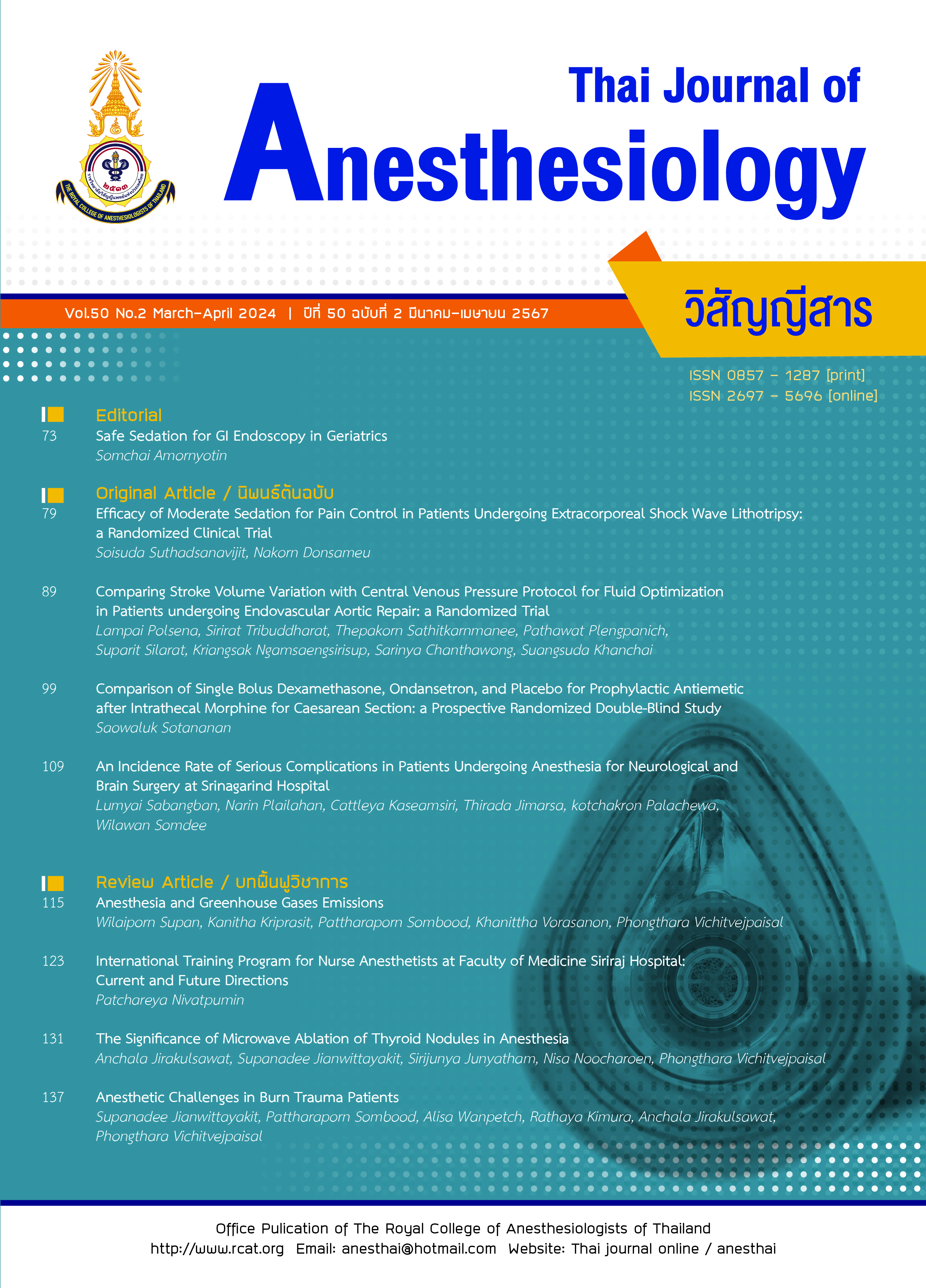Anesthetic Challenges in Burn Trauma Patients
Main Article Content
Abstract
Anesthetic management in burn patients requires a thorough understanding of the unique challenges associated with burn injuries. Anesthesiologists play a vital role in the multidisciplinary approach to burn patient care, ensuring that patients receive optimal pain relief, fluid resuscitation, and airway management. The preoperative management of burn patients includes the assessment of burn depth and extent, evaluation of airway patency, inhalation injury, fluid resuscitation and electrolyte management, antibiotic prophylaxis, and nutritional support. During surgery, monitoring of vital signs, fluid and electrolyte balance, airway management, and pain management are critical aspects of anesthesia care. In the postoperative period, wound care, infection control, pain management, and rehabilitation are crucial. Pediatric burns, inhalation injury, burns with associated trauma, burns in pregnancy, and co-existing medical diseases are special considerations. Anesthetic management in burn patients poses unique challenges, such as hemodynamic instability, increased metabolic rate and oxygen consumption, airway edema, and obstruction. Future directions in burn patient care and anesthesia include the development of new pain management techniques. Improved wound care and infection control strategies may lead to better outcomes for burn patients.
Article Details

This work is licensed under a Creative Commons Attribution-NonCommercial-NoDerivatives 4.0 International License.
References
Jeschke MG, van Baar ME, Choudhry MA, Chung KK, Gibran NS, Logsetty S. Burn injury. Nat Rev Dis Primers. 2020;6:11.
Wischmeyer PE. Glutamine in burn injury. Nutr Clin Pract. 2019;34:681-7.
Holm S, Engström O, Petäjä I, Huss F. Does the estimation of burn extent at admission differ from the assessment at discharge? Scars Burn Heal. 2021;7:20595131211019403.
Datta PK, Aravindan A, Sreekumar JE, Singh A, Roy SG. Simple predictor of minute ventilation: Holliday-Segar revisited. Anesth Essays Res. 2018;12:24-5.
Csenkey A, Jozsa G, Gede N, et al. Systemic antibiotic prophylaxis does not affect infectious complications in pediatric burn injury: a meta-analysis. PLoS One. 2019;14:e0223063.
Griggs C, Goverman J, Bittner EA, Levi B. Sedation and pain management in burn patients. Clin Plast Surg. 2017;44:535-40.
Pardesi O, Fuzaylov G. Pain management in pediatric burn patients: review of recent literature and future directions. J Burn Care Res. 2017;38:335-47.
Bittner EA, Shank E, Woodson L, Martyn JAJ. Acute and perioperative care of the burn-injured patient. Anesthesiology. 2015;122:448-64.
Pelosi P, Ball L, Barbas CSV, et al. Personalized mechanical ventilation in acute respiratory distress syndrome. Crit Care. 2021;25:250.
Guilabert P, Usúa G, Martín N, Abarca L, Barret JP, Colomina MJ. Fluid resuscitation management in patients with burns: update. Br J Anaesth. 2016;117:284-96.
Ebrahimi A, Kalantar Motamedi MH. Application of silver sulfadiazine cream with early surgical intervention in patients suffering from combined burn-blast injury facial tattoos. Trauma Mon. 2012;17:255-8.
Esechie A, Bhardwaj A, Masel T, Raji M. Neuro-cognitive sequela of burn injury in the elderly. J Clin Neurosci. 2019;59:1-5.
Huang L, Sang CN, Desai MS. A chronology for the identification and disclosure of adverse effects of succinylcholine. J Anesth Hist. 2019;5:65-84.
Harbin KR, Norris TE. Anesthetic management of patients with major burn injury. AANA J. 2012;80:430-9.
Beushausen T, Mücke K. Anesthesia and pain management in pediatric burn patients. Pediatr Surg Int. 1997;12:327-33.
Palmieri TL. Burn injury and blood transfusion. Curr Opin Anaesthesiol. 2019;32:247-51.
Hughes A, Almeland SK, Leclerc T, et al. Recommendations for burns care in mass casualty incidents: WHO emergency medical teams
technical working group on burns (WHO TWGB) 2017-2020. Burns. 2021;47:349-70.
Romanowski KS, Carson J, Pape K, et al. American burn association guidelines on the management of acute pain in the adult burn patient: a review of the literature, a compilation of expert opinion, and next steps. J Burn Care Res. 2020;41:1129-51.
Tracy LM, Singer Y, Schrale R, et al. Epidemiology of burn injury in older adults: an Australian and New Zealand perspective. Scars Burn Heal. 2020;6:1-11.
Clark A, Imran J, Madni T, Wolf SE. Nutrition and metabolism in burn patients. Burns Trauma. 2017;5:11.
Duchin ER, Moore M, Carrougher GJ, et al. Burn patients’ pain experiences and perceptions. Burns. 2021;47:1627-34.
Barrett W, Buxhoeveden M, Dhillon S. Ketamine: a versatile tool for anesthesia and analgesia. Curr Opin Anaesthesiol. 2020;33:633-8.
Beushausen T, Mücke K. Anesthesia and pain management in pediatric burn patients. Pediatr Surg Int. 1997;12:327-33.
Huls CK, Detlefs C. Trauma in pregnancy. Semin Perinatol. 2018;42:13-20.
Radosevich MA, Finegold H, Goldfarb W, Troianos C. Anesthetic management of the pregnant burn patient: excision and grafting to emergency cesarean section. J Clin Anesth. 2013;25:582-6.
Folkestad T, Brurberg KG, Nordhuus KM, et al. Acute kidney injury in burn patients admitted to the intensive care unit: a systematic review and meta-analysis. Crit Care. 2020;24:2.


